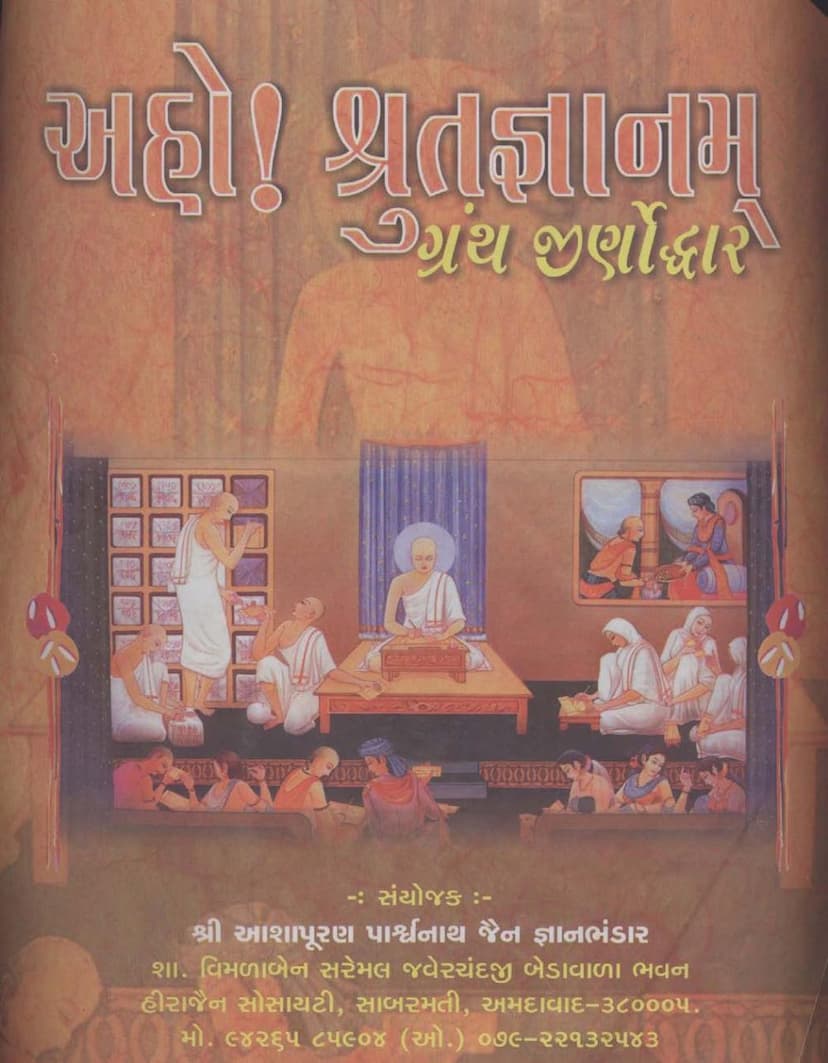Bikaner Jain Lekh Sangraha
Added to library: September 1, 2025

Summary
Based on the provided text, here is a comprehensive summary in English of the "Bikaner Jain Lekh Sangraha":
"Bikaner Jain Lekh Sangraha" (Collection of Jain Inscriptions from Bikaner) is a monumental work compiled and edited by Agarchand Nahta and Bhanvarlal Nahta, published by Nahta Brothers, Calcutta. This collection is a testament to the rich Jain history, culture, and artistic heritage of the Bikaner region in Rajasthan, India.
The book is part of a larger initiative, likely "Aho Shrut Gyanam" Granth Jīrṇoddhār (Preservation of Sacred Knowledge), aiming to preserve and disseminate ancient Jain texts. The presented pages primarily focus on the catalog of inscriptions and details related to the Bikaner Jain inscriptions.
Key Aspects and Content:
- Comprehensive Collection of Inscriptions: The core of the "Bikaner Jain Lekh Sangraha" is the meticulous compilation of a vast number of inscriptions found in the Bikaner region. These inscriptions, numbering in the thousands (as suggested by the detail in the later pages), are presented in chronological order and cover a significant historical period, from as early as the 10th century CE up to modern times.
- Details of Each Inscription: For each inscription, the book provides:
- Serial Number (Kram): A unique identifier for cataloging.
- Book Name (Pustak ka Naam): While the title refers to the overall collection, this might be a placeholder or reference to the specific source/location of the inscription within a larger publication series.
- Author/Commentator (Karta-Tikaakaar): The scholar who authored or commented on the original text or inscription.
- Language (Bhasha): The language of the inscription (e.g., Sanskrit, Prakrit, Hindi, Gujarati).
- Editor/Publisher (Sampadak/Prakashak): The individual or institution responsible for editing and publishing the inscription.
- Page Number (Prushth): The page number where the inscription's details or the inscription itself is found.
- Content Summary (Implicit): The extensive list of inscriptions indicates they cover various aspects like temple construction, idol installation, land grants, and dedications by individuals, families, and communities.
- Catalog Structure: The provided pages show a structured catalog, organized into sets (Set No. 1, Set No. 2, Set No. 3), which likely indicates the publication in volumes or sections. The catalog lists hundreds of Jain texts, many of which are ancient and rare, covering diverse subjects like:
- Agamas and Sutras: Nandi Sutra, Uttaradhyayana Sutra.
- Philosophy and Logic: Arhaddita-Bhagavad Gita, Yukti Prakash Sutra, Manatunga Shastra, Nyayavataar, Anekanata Jayapataka, etc.
- Architecture and Sculpture (Shilpa Shastra): Aprajita Prichchha, Shilpa Smriti Vastu Vidya, Shilpa Ratna, Prasad Tilak, Kashya Shilpa, Prasad Manjari, Rajavallabha, Vastu Sara, Deeparnava, Jinprasad Martanda, etc.
- Astrology and Jyotisha: Hirakalash Jain Jyotisha.
- Grammar: Prakrit Vyakarana.
- Law and Ethics: Vidya Vyapti Panchak Vivriti, Vidya Viveka Vilas, etc.
- Mythology and History: Jain Granthaavali, Virat Kathakosh, etc.
- Temple History and Architecture: The detailed introduction and subsequent lists of inscriptions focus heavily on the history of Jain temples in Bikaner and surrounding regions, providing names, locations, and construction/installation dates.
- Bikaner's Jain Heritage: The introduction and the catalog highlight Bikaner's historical significance as a center of Jainism. It mentions the role of Jains in the state's establishment and administration, the patronage of Jain Acharyas by Bikaner rulers, the rich Jain literature composed in the region, and the history of numerous Jain temples and monastic quarters (Upashrayas).
- Dedication and Purpose: The book is dedicated to the memory of Babu Pooranchandji Nahar, recognizing his lifelong contribution to the collection, preservation, advancement, and publication of Jain archaeology, literature, culture, and art. The work itself is described as an effort to bring ancient, often unobtainable, texts to light through scanning and DVD creation, making them accessible via the website.
- Historical Context of Epigraphy: The introductory sections (like "Vakthavya" and "Bhumika") discuss the importance of inscriptions as authentic historical sources, comparing them with literary sources and highlighting the challenges in deciphering and dating ancient scripts. It mentions specific significant Jain inscriptions like the Kharavela inscription and discusses the prevalence of Jainism in different regions of India.
- Detailed Description of Bikaner's Jain Sites: A significant portion of the book is dedicated to detailing the history and epigraphy of various Jain temples and monastic establishments in Bikaner city and its surrounding areas. This includes descriptions of prominent temples like Shri Chintamani Ji, Shri Shantinath Ji, Shri Sumatinath Ji (Bhandasar Ji), Shri Simandhar Swami, Shri Namjinath Ji, Shri Mahavir Swami, Shri Vasupujya Ji, Shri Rishabhdev Ji, Shri Parshvanath Ji, Shri Ajitnath Ji, Shri Vimalnath Ji, and many others. It also lists numerous Upashrayas and ancillary religious structures.
- Sati Monuments: The collection also includes inscriptions related to Jain Sati monuments, detailing the practice of Sati and its eventual abolition, along with lists of families and their contributions.
- Biographical Information: There are brief biographical notes on key figures involved in the compilation, such as Shah Babulal Suremal, and benefactors like Shri Mulchandji Nahata, highlighting their contributions to Jain literature and heritage.
- Linguistic and Paleographic Importance: The inscriptions are in various languages and scripts, offering valuable data for linguistic and paleographic studies of ancient Indian languages and writing systems.
- Artistic and Cultural Insights: The inscriptions shed light on the development of Jain art, sculpture, and architecture over centuries, as evident from the descriptions of temple designs, idol styles, and decorative elements.
Overall Significance:
The "Bikaner Jain Lekh Sangraha" is an invaluable resource for scholars, researchers, historians, and anyone interested in Jainism, Indian history, archaeology, art, and culture. It systematically documents a wealth of epigraphic material, providing primary source data for understanding the spread and evolution of Jainism, the lives of Jain saints and patrons, and the artistic achievements of the Jain community in the Bikaner region. The meticulous cataloging and detailed information make it a foundational work for the study of North Indian Jain heritage.